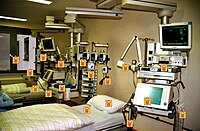
Photo from wikipedia
BackgroundThis project aims to study the use of antibiotics in three clinical wards in the largest tertiary teaching hospital in Ethiopia for a period of 1 year. The specific aims… Click to show full abstract
BackgroundThis project aims to study the use of antibiotics in three clinical wards in the largest tertiary teaching hospital in Ethiopia for a period of 1 year. The specific aims were to assess the prevalence of patients on antibiotics, quantify the antibiotic consumption and identify the main indications of use.MethodThe material was all the medical charts (n = 2231) retrieved from three clinical wards (internal medicine, gynecology/obstetrics and surgery) in Tikur Anbessa Specialized Hospital (TASH) in Addis Ababa between September 2013 and September 2014. Data collection was performed manually by four pharmacists.ResultsEach medical chart represented one patient. About 60% of the patients were admitted to internal medicine, 20% to each of the other two wards. The number of bed days (BD) was on average 16.5. Antibiotics for systemic use were prescribed to 73.7% of the patients (on average: 2.1 antibiotics/patient) of whom 86.6% got a third or fourth generation cephalosporin (mainly ceftriaxone). The average consumption of antibiotics was 81.6 DDD/100BD, varying from 91.8 in internal medicine and 71.6 in surgery to 47.6 in gynecology/obstetrics. The five most frequently occurring infections were pneumonia (26.6%), surgical site infections (21.5%), neutropenic fever (6.9%), sepsis (6.4%) and urinary tract infections (4.7%). About one fourth of the prescriptions were for prophylactic purposes. Hospital acquired infections occurred in 23.5% of the patients (353 cases of surgical site infection). The prescribing was based on empirical treatment and sensitivity testing was reported in only 3.8% of the cases.ConclusionsIn the present study from three wards in the largest tertiary teaching hospital in Ethiopia, three out of four patients were prescribed antibiotics, primarily empirically. The mean antibiotic consumption was 81.6 DDD/100BD. Surgical site infections constituted a large burden of the infections treated in the hospital, despite extensive prescribing of prophylaxis. The findings show the need to implement antibiotic stewardship programs in Ethiopian hospitals with focus on rational prescribing, increased sensitivity testing and better procedures to prevent hospital acquired infections.
Journal Title: BMC Health Services Research
Year Published: 2018
Link to full text (if available)
Share on Social Media: Sign Up to like & get
recommendations!